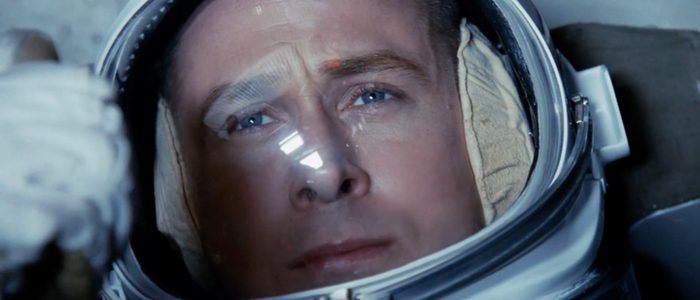If one is to believe those who knew the very private and humble astronaut Neil Armstrong best, then the new film “First Manâ€, which profoundly probes his personal life, would probably not be the kind of film Armstrong would approve of in its detailed exposition of his inner struggles.
In director Damien Chazelle’s biopic about the first man to set foot on the moon, its focus is far less on Armstrong and NASA’s amazing accomplishment which serves as film’s obvious and spectacularly filmed climax. Instead, the film is a deeply personal examination of Armstrong’s private inner sadness in the wake of personal tragedy, carefully protected by an outward calm, determination and steely professionalism.
Armstrong saw his demanding and dangerously risky pivotal role in the historic 1969 first landing of man on the moon as simply doing his job for science and space exploration, and most assuredly not for personal fame, glory and unwanted attention
Yet, however Armstrong humbly saw himself in the great scheme of things surrounding one of Mankind’s greatest achievements; the fact remains his accomplishment, and that of his brave colleagues, remains the stuff of legend previously presented in all its deserved grandeur on the big screen in such films as “The Right Stuff†and “Apollo 13â€.
While “First Man†admirably attempts to show us a deeper layer to the heroic public perception of Armstrong, the execution of this task, while empathetic, is cinematically lackluster and dull. Chazelle and lead actor Ryan Gosling present Armstrong as a man who is somber, outwardly guarded and haunted by heart-wrenching memories of the death of his small daughter Karen from a brain tumor.
Not long after this tragedy, Armstrong is invited to join the elite group of astronauts, engineers and test pilots for NASA’s Gemini program in the early 1960’s, whose ultimate aim is to land on a man on the moon following President John Kennedy’s visionary directive.
However, Gosling’s portrayal of Armstrong, however earnest and grounded in fact, is so repetitively low-key and restrained that Armstrong, and by extension the film, is lackluster and boring to the audience. It seems no matter what takes place surrounding Armstrong, his reserve and reticence to show emotion becomes tedious within this narrative.
This psychological struggle within Armstrong is depicted on screen by director Chazelle in a repetitive series of gauzy flashbacks that plague his hero’s mind and memory throughout the film. For a film that presents itself, even minimally, as a journey to the spectacular expanse of space, the moon and the stars; “First Man†spends an inordinate amount of time in a claustrophobic, dark place within Armstrong’s tragic internal recollections and pain over his daughter’s death.
Chazelle does attempt to chronicle the years of preparation, danger and tragic setbacks that beset the NASA program from Gemini and Apollo that preceded the first moon landing with an eye for detail. The director effectively captures through the camera lens the danger and claustrophobia the various astronauts faced in those early missions, strapped into spacecraft that often seem little more than high-tech tin cans that shake, rattle and groan with every dangerous and unprecedented liftoff. Though at times, Chazelle’s reliance on shaky cam close-ups during these sequences borders on nausea inducing tedium.
The most egregious shortcoming in “First Man†occurs during what should have been its spectacular, awe inspiring climax; the moon landing itself. Granted, Chazelle does indeed deliver the eye-popping visual goods befitting its presence on an IMAX screen. The astoundingly bleak yet beautiful vista of the vast lunar landscape amid the haunting dead silence on the moon’s surface is undeniably the film’s highlight.
The pre-release controversy over Chazelle’s decision to not definitively show Armstrong planting the American flag on the moon surface as “Anti-American†proves to ultimately be much ado about nothing. We see the American flag standing proud in several shots on the moon’s surface ably giving a nod to America’s historic achievement without overly jingoistic fanfare. Far more effective is a close up shot of the placement of man’s first footprint from Armstrong’s boot on the dusty moon surface to show the grand significance of this moment.
Sadly, Chazelle mucks up the grand promise of this lunar sequence we’ve waited throughout a tediously lackluster majority of the film to witness; only to be abysmally shortchanged and insulted. After a few all too brief scenes of the wondrous lunar landscape with Armstrong and his colleague Buzz Aldrin on the surface amounting to a few scant minutes; Gosling’s Armstrong once again brings us back to the somber memories of his tragically deceased daughter.
Chazelle opts to cut away from the spectacular lunar view that surrounds Armstrong, to once again shower us with imagery of the stoic astronaut thinking about his daughter and his subsequent sadness over her loss on Earth. These flashbacks culminate in an outrageously manipulative, however factual, rip-off of one of the final scenes in the film “Titanicâ€. The implied significance of Armstrong’s action is that he’s letting go of his troubled memories of his daughter; but the scene falls flat in its misplaced attempt at poignancy.
“First Man†aims high to peel away the layers of Neil Armstrong’s carefully guarded public persona to reveal a man of deep complexity and filled with hidden pain. It succeeds in the pursuit of that specific revelation. However, it shortchanges the grandeur of Armstrong’s supreme and historic accomplishment by focusing too much and too long on those inner struggles.
Such a focus may make a compelling character study for discussion and intellectual analysis; but such a one-note narrative by Chazelle and an unwaveringly stoic performance by Gosling makes for a very dull cinema experience.





